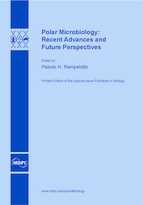Polar Microbiology: Recent Advances and Future Perspectives
A special issue of Biology (ISSN 2079-7737).
Deadline for manuscript submissions: closed (30 November 2012) | Viewed by 261506
Special Issue Editor
Interests: microbiome; molecular microbiology; metagenomics; omics; biostatistics; next-generation sequencing; clinical research; bioinformatics; biotechnology; system biology; grand challenges
Special Issues, Collections and Topics in MDPI journals
Special Issue Information
Dear Colleagues,
Polar microbiology is a promising field of research that can tell us much about the fundamental features of life. The microorganisms that inhabit Arctic and Antarctic environments are important not only because of the unique species they represent, but also because of their diverse and unusual physiological and biochemical properties. Furthermore, microorganisms living in Polar Regions provide useful models for general questions in ecology and evolutionary biology given the reduced complexity of their ecosystems, the relative absence of confounding effects associated with higher plants or animals, and the severe biological constraints imposed by the polar environment. In terms of applied science, the unique cold-adapted enzymes and other molecules of polar microorganisms provide numerous opportunities for biotechnological development. Another compelling reason to study polar microbial ecosystems is the fact that they are likely to be among the ecosystems most strongly affected by global change. For these reasons, polar microbiology is a thriving branch of science with the potential to provide new insights into a wide range of basic and applied issues in biological science. In this context, it is timely to review and highlight the progress so far and discuss exciting future perspectives. In this special issue, some of the leaders in the field describe their work, ideas and findings.
Prof. Pabulo Henrique Rampelotto
Guest Editor
Keywords
- biodiversity
- biogeochemistry
- biogeography
- biotechnology
- evolutionary biology
- genetics, genomics and proteomics
- microbiology
- molecular biology
- molecular ecology
- physiology and metabolism
Benefits of Publishing in a Special Issue
- Ease of navigation: Grouping papers by topic helps scholars navigate broad scope journals more efficiently.
- Greater discoverability: Special Issues support the reach and impact of scientific research. Articles in Special Issues are more discoverable and cited more frequently.
- Expansion of research network: Special Issues facilitate connections among authors, fostering scientific collaborations.
- External promotion: Articles in Special Issues are often promoted through the journal's social media, increasing their visibility.
- Reprint: MDPI Books provides the opportunity to republish successful Special Issues in book format, both online and in print.
Further information on MDPI's Special Issue policies can be found here.







